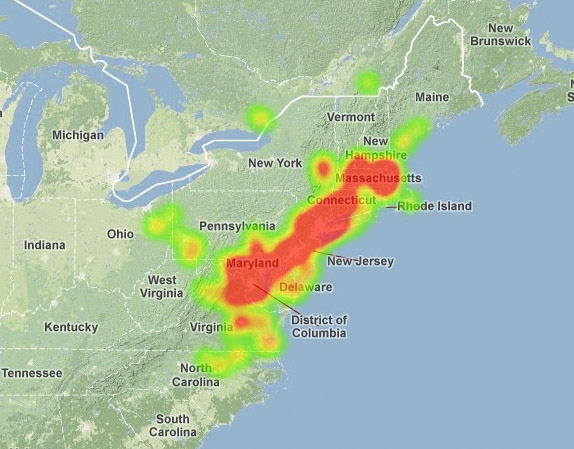Meteor Over Manhattan: East Coast Fireball Sets Internet Abuzz

A bright meteor briefly outshined the lights of New York City Friday evening (March 22), according to reports by witnesses who used Twitter and the Internet to report sightings of the fireball streaking over a broad stretch of the U.S. East Coast.
"Strange Friday night … a meteor passed over my house tonight!" wrote one New Yorker writing as Yanksmom19.
The first fireball sightings came at about 8 p.m. EDT (0000 March 23 GMT) and sparked more than 500 witness reports to the American Meteor Society. Reports of the meteor flooded Twitter from New York, Boston and Washington, D.C.
"The witnesses range from along the Atlantic Coast ranging from Maine to North Carolina," Robert Lunsford, the society's fireball coordinator, wrote in an update. "This object was also seen as far inland as Ohio." [5 Amazing Fireball Videos]
The CBS WUSA 9 television news station obtained several security camera videos of the fireball as it lit up the night sky over Washington and parts of Maryland.
In New York, some observers reported seeing the meteor low in the sky as it streaked from west to east across the night sky.
"It shot over Manhattan and broke up over the East Village," observer Ross E. of New York City wrote in his fireball report to the meteor society. In fact, the meteor streaked across hundreds of miles and was visible from many states along the Eastern Seaboard.
Breaking space news, the latest updates on rocket launches, skywatching events and more!
According to Lunsford, meteors often appear closer than they actually are due to the observer's perspective.
Fireballs occur every day and are typically caused by small space rocks about the size of a basketball disintegrating as they streak through Earth's atmosphere, officials with NASA's Asteroid Watch outreach program wrote in a Twitter post.
On Feb. 15, a bus-size meteor exploded over Russia near the city of Chelyabinsk, shattering windows in hundreds of buildings and injuring nearly 1,500 people. That rare meteor explosion, which scientists have classified as a superbolide, was the most powerful in more than a century, NASA scientists said.
The Earth is bombarded by nearly 100 tons of material from space every day, but most of those objects are tiny dust grains that burn up harmlessly in the atmosphere.
NASA scientists and astronomers around the world regularly monitor the night sky for signs of larger asteroids that could pose an impact threat to Earth. Friday night's meteor came just days after back-to-back hearings in the House and Senate about the dangers posed by near-Earth asteroids. Those meetings were scheduled in the wake of the Feb. 15 Russian meteor explosion.
Editor's note: If you snapped an amazing photo of the East Coast meteor or any other night sky sight and you'd like to share it for a possible story or image gallery, please send images and comments, including location information, to Managing Editor Tariq Malik at spacephotos@space.com.
Email Tariq Malik at tmalik@space.com or follow him @tariqjmalik and Google+. Follow us @Spacedotcom, Facebook and Google+. Original article on SPACE.com.

Tariq is the award-winning Editor-in-Chief of Space.com and joined the team in 2001. He covers human spaceflight, as well as skywatching and entertainment. He became Space.com's Editor-in-Chief in 2019. Before joining Space.com, Tariq was a staff reporter for The Los Angeles Times covering education and city beats in La Habra, Fullerton and Huntington Beach. He's a recipient of the 2022 Harry Kolcum Award for excellence in space reporting and the 2025 Space Pioneer Award from the National Space Society. He is an Eagle Scout and Space Camp alum with journalism degrees from the USC and NYU. You can find Tariq at Space.com and as the co-host to the This Week In Space podcast on the TWiT network. To see his latest project, you can follow Tariq on Twitter @tariqjmalik.

